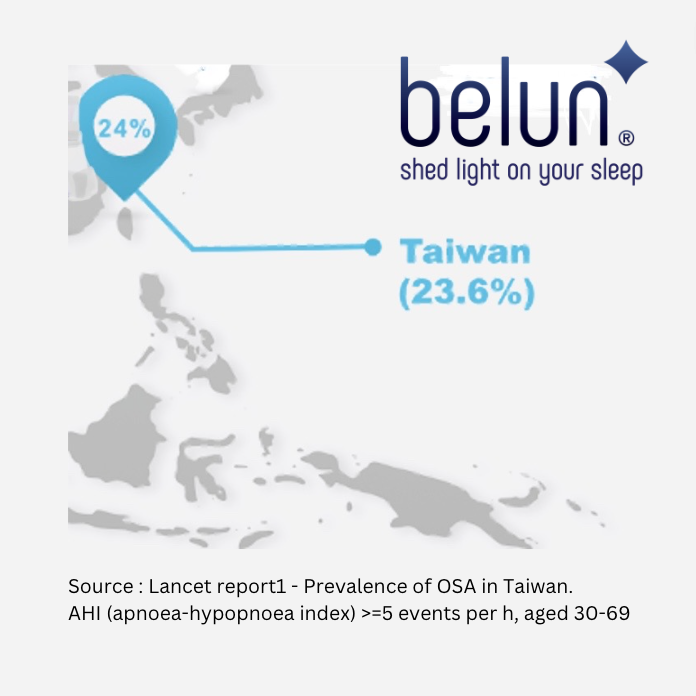Belun Ring received Taiwan FDA clearance as a Class II medical-grade wearable in Feb 2023. The Company is partnering with some new health-check companies to integrate sleep checks to customize a holistic healthcare package for the Taiwanese. The Belun Sleep System has also received US FDA-510(k) clearance as the first AI-enabled medical-grade wearable ring for sleep apnea diagnosis with sleep stages. It has been clinically validated in accredited sleep labs to provide accurate AHI, sleep stages, and autonomic nervous system response. Belun Sleep System enhances sleep health management in both HSAT & remote patient monitoring with its multi-night testing & reusable capability.
Taiwan as a Pill-Popping country
More than one in five people in Taiwan has insomnia, likely caused by stress due to economic woes. With 21.8 percent of its population having chronic trouble falling asleep or staying asleep & in 2022, the country consumed 10.5 billion sleeping pills, making it the “Island of Insomnia”
Keep people healthy with our preventive healthcare data
Belun’s CEO, Dr. Lydia Leung, shared: “We hope to collaborate with more partners to solve the problem of the Island’s sleep disorder. Being part of the CBT-I (cognitive behavior treatment – insomnia) of Hong Kong’s public hospital program, Belun Ring, acting as the digital sleep diary, would help clinical psychologists to understand the patients’ sleep stages (also FDA 510(k) cleared) better, differentiate OSA, insomnia and COMISA (OSA x Insomnia), and thus devising a more personalized treatment journey.” Research shows sleep health is critical for the overall immune system & treatment effectiveness of chronic diseases. Currently, the Company is also supporting research on post-stroke patients at a local hospital in Taipei.
The company is expanding towards Preventive Healthcare from the original sleep health. Since the launch of the 1st generation Belun Ring in 2018, it’s now widely used in research on long-term diseases, including stroke, hypertension, insomnia, dementia, cardiovascular-related risk, etc.

Chronic Disease Management via AI Preventive Healthcare
Belun’s vision is to help people better manage their chronic diseases through artificial intelligence and big data analytics to alleviate medical expenditures due to the aging population. Our solution allows caregivers and patients to follow their treatment effectiveness, select personalized solutions, and enhance treatment compliance. Lydia further shared: “Long-term monitoring using medical-grade wearables can help people to identify abnormalities earlier to achieve preventive healthcare.”

Partnering with Belun :
Up to now, over a hundred organizations, including HK hospital authority hospitals, medical groups, clinic groups, dentists, and elderly centers selected to use the Belun Sleep System, Belun Ring, and Belun® remoVital monitoring system. Many doctors read our medical journal papers, including:
1) “Belun® Ring Platform: a novel home sleep apnea testing system for assessment of obstructive sleep apnea” (https://jcsm.aasm.org/doi/10.5664/jcsm.8592),
2) “Detection of obstructive sleep apnea using Belun Sleep Platform wearable with neural network based algorithm and its combined use with STOP-Bang questionnaire” (https://journals.plos.org/plosone/article?id=10.1371/journal.pone.0258040),
3)Belun® Ring (Belun Sleep System BLS-100): Deep Learning-Facilitated Wearable Enables OSA Detection, Apnea Severity Categorization, and Sleep Stage Classification in Patients Suspected of OSA (https://journals.lww.com/jhypertension/Abstract/2023/06000/The_Belun_sleep_platform_to_diagnose_obstructive.16.aspx),
4) Correlation of Pulse Rate Variability(PRV) and Heart Rate Variability(HRV) Metrics During Sleep in Subjects Suspected of OSA (Accepted in SLEEP conference 2023, Abstract ID: 954).
If you would like to know more about how to adopt Belun’s solution in your organization or home use, please feel free to contact us to schedule a meeting by filling out the form below:
Your message has been sent
References
1.A.V, Benjafield et al, Lancet Respiratory Medicine, 2019; 2. Susanna Ng et al, PLOS One, 2015


